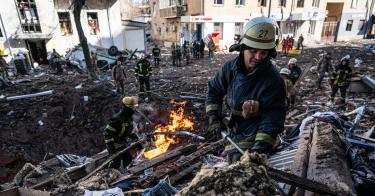Most Americans view nuclear weapons as a relic of the Cold War. President Ronald Reagan and Soviet leader Mikhail Gorbachev agreed in 1985 “that a nuclear war can never be won and must never be fought.” That thinking has remained a “given” for the last 37 years. Unfortunately, Russian President Vladimir Putin may have other ideas.
Just five days before Russia invaded Ukraine, Putin personally oversaw nuclear exercises and issued subtle nuclear threats against the West should Ukraine become a part of NATO. Once his war begun, the threats became less subtle. More recently, Putin ordered his nuclear forces on high alert. While the Pentagon reports it has not detected significant changes in Russia’s nuclear posture, Putin’s nuclear muscle flexing has prompted concern over how far he will go.
A Russian nuclear attack on Ukraine—or worse, against a NATO state—is unlikely. Doing so would break a 75-year nuclear taboo while completely alienating the rest of the world from Russia. But the chances are not zero, either. The U.S. must take the threat seriously.
>>> Russia Links Ukraine Sanctions to Iran Nuclear Talks to Shake Down Biden Administration
When it comes to nuclear long-range missiles—those able to reach each other’s homelands—the U.S. and Russia have rough parity stemming from the New START arms control treaty. But Russia also has more than 2,000 low-yield, tactical nuclear weapons that are meant for use on a battlefield. In this category, Russia’s weapons outnumber the U.S. at least 10 to 1.
The prevailing American view is that nuclear weapons should be used only for deterrence. But Russia’s official warfighting doctrine specifically reserves the right to use tactical nuclear weapons in a conventional conflict to compel the enemy to back down.
Here’s where the nuclear danger comes in. If Russia continues to fail in its conventional military efforts to seize Ukrainian cities and topple the Ukrainian government, Putin might be tempted to fire a tactical nuclear weapon to compel Ukrainians to surrender and signal to the West that he will not take failure as an option.
A nuclear attack on Ukraine, even with a very small nuclear weapon, would cause severe destruction and take thousands of lives if launched at a populated area. While NATO would not be obliged to respond militarily, such an attack would likely lead to further Russian isolation from the world and unite countries against Putin.
A nuclear attack on a NATO state is less likely. Putin knows any nuclear attack will be met with a nuclear response. But short of launching a nuclear weapon at a NATO state, Putin may issue further nuclear threats against NATO intervention in Ukraine.
Indeed, Putin’s order to move Russia’s nuclear weapons on higher alert was likely meant to scare away the West from getting involved. Or, if Ukraine continues to repel Russian forces, Putin may threaten nuclear attack to compel the West to stop sending military equipment to Ukraine.
>>>What China Is Learning From Putin’s Ukraine Invasion
War against a major nuclear power—especially one that views nuclear weapons as “useable”—introduces complexities into the fight and forces the United States and its allies to proceed with caution. But by the same measure, NATO is a nuclear alliance, too. To deter nuclear war with Russia, NATO must be sure to communicate its resolve to use nuclear weapons if attacked.
Moving forward, the United States must ensure that a strong nuclear deterrence is at the top of its agenda. After the Cold War, the United States retired thousands of nuclear weapons while letting its existing forces become older and older. Now, the U.S. is scrambling to replace its nuclear forces with modern systems before they age into obsolescence.
Putin’s recent inflammatory rhetoric, nuclear saber-rattling and military actions in Ukraine are proof of the need for a strong, modern U.S. nuclear force. Indeed, the nuclear dangers in Ukraine have taught us that nuclear war is a 21st century concern. As much as U.S. policymakers might like to wish away nuclear weapons from existence, unfortunately, the enemy gets a vote.
This piece originally appeared in MSN.com



